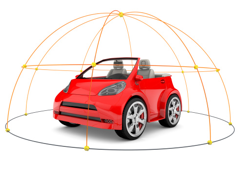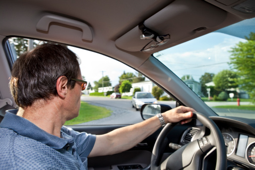There’s a distinct advantage to purchasing a new car rather than one that was pre-owned: the newer vehicle will probably have more safety features than its older counterpart. Years ago, you could buy a car with optional safety features like anti-lock brakes, air bags, and backup cameras. Today, all of this technology is standard equipment on most vehicles, and even newer gizmos on today’s cars can protect your safety even more.
One of the latest add-ons for vehicle safety is the crash-avoidance system. Using a variety of sensors and cameras, these systems can help the vehicle’s computer to detect unsafe conditions before the driver can, thereby reducing the chances of a collision. The Ford Fusion and the Subaru Legacy are a couple vehicles which offer this technology.
Â
But now, you can install a crash-avoidance system on your own vehicle – even if it wasn’t there when you purchased it from the dealer.
Get a Crash-Avoidance System Without Buying a New Car
A New York company called Safe Drive Systems has revealed a new crash-avoidance system that acts as an “aftermarket” accessory to any vehicle that was manufactured this century. This product uses radar technology to monitor the road in front of the vehicle in order to notify the driver of any obstructions, slowing traffic, or other dangers which can lead to an accident. If necessary, drivers can turn off the system using the turn signal.
A spokesman for Safe Drive Systems says that the company is unveiling two different versions of this technology. The Premier system costs about $1,100 to be installed on most vehicles, and it issues audible and visual warnings from a device mounted on the dashboard near the steering wheel. Premier has the capability to scan the road 20 times per second for up to 460 feet in front of the vehicle.
The more advanced version, called Premier Plus, also utilizes lane-departure technology in case the vehicle drifts out of its lane. This is accomplished by a camera placed near the windshield which scans lane marking on the road. Premier Plus costs around $1,700 to install.
No Automatic Braking
It should be noted that neither Premier nor Premier Plus incorporates autonomous braking into their systems. Autonomous braking, which is available on some factory-installed crash-avoidance systems, automatically engages the brake if the computers determine that a collision is imminent or likely. The Safe Drive Systems spokesman says that this aspect may be added to its product line sometime in the future.
Will Crash-Avoidance Systems Lower Your Insurance Rates?
Many drivers know that certain automotive features and devices, like car alarms, air bags, and vehicle locator systems, can lower auto insurance premiums for the vehicle’s owner. However, that is not the case right now with aftermarket crash-avoidance systems like Premier or Premier Plus. That’s because there isn’t any data thus far to support the supposition that this technology lowers the incidence of auto accidents or the related claims. Hopefully, that will change in the future as more people install these systems on their vehicles.
If you want to reduce your auto insurance rates without installing expensive technology on your vehicle, you can visit AISInsurance.com. The Auto Insurance Specialists Web site allows you to receive multiple quotes for auto insurance policies within minutes, and you may be able to save hundreds of dollars a year on your premiums. So check out the AIS site today!
Written by Chris Martin
The information in this article was obtained from various sources. This content is offered for educational purposes only and does not represent contractual agreements, nor is it intended to replace manuals or instructions provided by the manufacturer or the advice of a qualified professional. The definitions, terms and coverage in a given policy may be different than those suggested here and such policy will be governed by the language contained therein. No warranty or appropriateness for a specific purpose is expressed or implied.




